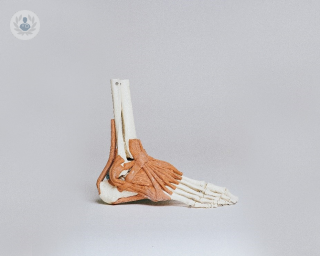Heel spur
Mr Matthew Solan - Orthopaedic surgery
Created on: 11-13-2012
Updated on: 06-20-2023
Edited by: Conor Lynch
What is a heel spur?
A heel spur is a calcium deposit in the heel produced as a result of excessive and continuous stretching of the plantar fascia, a ligament that connects the heel to the foot. Heel spurs cause the heel bone to protrude very slightly. Some heel spurs are very small and difficult to pick up on an X-ray.

What is the outlook for a heel spur?
If it is not treated in time, heel spur can become chronic, resulting in a very painful and difficult-to-cure condition.
What are the symptoms of a heel spur?
Patients can often have a heel spur without symptoms. When symptoms do occur, the most common ones are pain and swelling in the area around the heel, and difficulty with putting weight on the heel. The pain is usually felt on the inside on the heel and worsens when one is active.
How is a heel spur diagnosed?
Diagnosis of a heel spur usually requires an X-ray examination to get a better view of the heel bone.
What causes heel spurs?
There are many causes of a heel spur. Most commonly, they occur as a result of:
- having a very arched foot (cavus foot) which can be the result of neurological injury or a genetic condition
- being overweight
- wearing poor-fitting shoes
- having poor posture while standing
How can heel spurs be prevented?
Even if you have a genetic condition that affects the structure of your foot, it is possible to prevent heel spurs by taking appropriate steps. You may require orthotic insoles or adapted shoes to properly support your foot.
Everyone can help to avoid heel spurs by wearing correctly-fitting shoes, and taking extra care to wear suitable footwear when playing sports. Maintaining a healthy weight is important when it comes to preventing heel spurs from occurring.
How are heel spurs treated?
There are numerous ways in which heel spurs can be treated. Treatment usually involves:
- the use of orthopaedic insoles that relieve the heel of tension
- wearing night splints
- stretching exercises
- anti-inflammatory medication
In the vast majority of people these treatments will improve symptoms of heel spurs. In some patients, however, surgery may be necessary to correct the spur and relieve pain caused by inflammation of the plantar fascia.
Which specialist should I see for heel spurs?
Podiatrists specialise in the examination, assessment, and treatment of foot problems like heel spurs. If you see your GP about a foot problem and they are unable to make a diagnosis themselves they are likely to refer you to a podiatrist. In the UK podiatrists are also known as chiropodists. Depending on the treatment recommended, you may also see a physiotherapist or orthopaedic surgeon.
Are heel spurs more common as we age?
Various studies that have been carried out on heel spurs have shown that both men and women are at a higher risk of suffering from a heel spur the older they become.
Are all heel spurs painful?
Interestingly, not all heel spurs cause pain. In fact, approximately 38 per cent of the general population actually suffer from heel spurs, with roughly half of them not even being aware that they have one.
What is the relationship between heel spurs and osteoarthritis?
Patients with osteoarthritis are more prone to heel spurs due to the fact that osteoarthritis erodes the cartilage at the joints away. The foot will then desperately attempt to compensate for the loss of the cartilage, and as a direct result, the foot is likely to develop and be exposed to painful bone spurs.
Will I need surgery for my heel spur?
Patients' heel spurs are very rarely surgically removed. Only in extreme cases might the heel spur be surgically removed.





